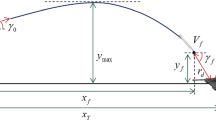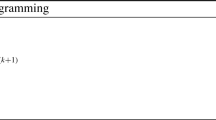Abstract
This paper presents a Legendre pseudo-spectral method for solving trajectory optimization problems with realistic state and input constraints. Fuel mass flow rate, rate of bank angle, amount of fuel, and angle of attack as considered as constraints. The final flight path angle and minimum final velocity constraints are added for a high probability of interception and maneuverability. Lift/drag coefficients and specific impulse which are functions of Mach number, angle of attack, and altitude, were handled with the lagging technique. These parameters are fixed at the current optimization iteration and updated at the next iteration. The original problem is converted to a free-final time problem using a time scale variable, which is an additional optimization variable. In the Pseudo-Spectral method, states and inputs are approximated with the Lagrange polynomial at every flipped Legendre–Gauss-Radau (LGR) collocation point. Dynamic constraints and other constraints are transcribed to algebraic equations at these LGR points. This discretized problem is solved with a MATLAB optimization solver, and values of states and inputs at every LGR collocation point are obtained. The Pseudo-Spectral method is proven to be effective in solving a trajectory optimization problem having realistic constraints, and is robust in solving trajectory optimization problems with a crude initial guess. A numerical simulation validates that this method produces accurate results with a small number of node points.
Access this chapter
Tax calculation will be finalised at checkout
Purchases are for personal use only
Similar content being viewed by others
References
Murtaugh SA, Criel HE (1966) Fundamentals of proportional navigation. IEEE Spectr 3(12):75–85
Jeon IS, Lee JI (2010) Optimality of proportional navigation based on nonlinear formulation. IEEE Trans Aerosp Electron Syst 46(4):2051–2055
Morgan RW, Tharp H, Vincent TL (2011) Minimum energy guidance for aerodynamically controlled missiles. IEEE Trans Autom Control 56(9):2026–2037
Kim I, Choi H-LJI-S (2021) Closed-form impact-angle-control guidance of nose-dive missiles for maximum terminal speed. Int J Aeronaut Space Sci 2021:1–12
Yogaswara Y, Hong S-M, Tahk M-J, Shin H-S (2017) Impact angle control guidance synthesis for evasive maneuver against intercept missile. Int J Aeronaut Space Sci 18(4):719–728
Roh H, Oh Y-J, Tahk M-J, Kwon K-J, Kwon H-H (2019) L1 penalized sequential convex programming for fast trajectory optimization: with application to optimal missile guidance. Int J Aeronaut Space Sci 21(2):493–503
Fahroo F, Ross IM (2012) Direct trajectory optimization by a chebyshev pseudospectral method. J Guid Control Dyn 25(1):160–166
Topputo F, Zhang C (2014) Survey of direct transcription for low-thrust space trajectory optimization with applications. Abstract Appl Anal
Sagliano M (2019) Generalized HP pseudospectral-convex programming for powered descent and landing. J Guid Control Dyn 42(7):1562–1570
Park B-G, Ahn J-S, Tahk M-J (2011) Two-dimensional trajectory optimization for soft lunar landing considering a landing site. Int J Aeronaut Space Sci 12(3):288–295
Garg D, Patterson M, Hager W, Rao A, Benson D, Huntington G (2017) An overview of three pseudospectral methods for the numerical solution of optimal control problems
Garg D, Patterson M, Hager WW, Rao AV, Benson DA, Huntington GT (2010) A unified framework for the numerical solution of optimal control problems using pseudospectral methods. Automatica 46(11):1843–1851
Mayer A, Halswijk W, Komduur H, Lauzon M, Stowe RA (2005) A modular ducted rocket missile model for threat and performance assessment. In: AIAA modeling and simulation technologies conference and exhibit, San Francisco (2005)
Rosema C, Doyle J, Auman L, Underwood M, Blake WB (2011) MISSILE DATCOM user’s manual - 2011 revision. Defense Technical Information Center
Komornik D, Gany A (2019) Investigation of a ducted rocket with a paraffin/oxygen hybrid gas generator. Int J Guid Control Dyn 35(6):1108–1115
Fleeman EL (2006) Tactical missile design. American Institute of Aeronautics and Astronautics, Reston 2–6
Liu X, Shen Z, Lu P (2016) Exact convex relaxation for optimal flight of aerodynamically controlled missiles. IEEE Trans Aerosp Electron Syst 52(4):1881–1892
Kwon H-H, Choi H-L (2019) A convex programming approach to mid-course trajectory optimization for air-to-ground missiles. Int J Aeronaut Space Sci 21(2):479–492
Acknowledgements
This work was supported by the Theater Defense Research Center funded by the Defense Acquisition Program Administration under Grant UD200043CD.
Author information
Authors and Affiliations
Corresponding author
Editor information
Editors and Affiliations
Rights and permissions
Copyright information
© 2023 The Author(s), under exclusive license to Springer Nature Singapore Pte Ltd.
About this paper
Cite this paper
Jung, CG., Lee, CH., Tahk, MJ. (2023). Legendre Pseudo-Spectral Method for Missile Trajectory Optimization with Free Final Time. In: Lee, S., Han, C., Choi, JY., Kim, S., Kim, J.H. (eds) The Proceedings of the 2021 Asia-Pacific International Symposium on Aerospace Technology (APISAT 2021), Volume 2. APISAT 2021. Lecture Notes in Electrical Engineering, vol 913. Springer, Singapore. https://doi.org/10.1007/978-981-19-2635-8_42
Download citation
DOI: https://doi.org/10.1007/978-981-19-2635-8_42
Published:
Publisher Name: Springer, Singapore
Print ISBN: 978-981-19-2634-1
Online ISBN: 978-981-19-2635-8
eBook Packages: EngineeringEngineering (R0)




